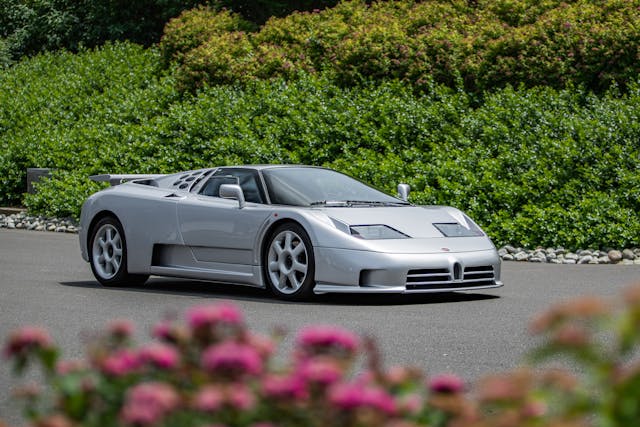Crank up the Alanis Morissette: ’90s hypercars to take over Monterey 2021
Monterey is where the best-of-the-best collector cars are put on display and offered for public auction. It’s a big deal.
The weekend has typically been the home of blueblood classics like 300 SLs, D-Types, and Ferraris of the 250-variety. Recently, however, modern hypercars have stolen the show. At RM Monterey 2019, the last time the auction was held in person, a 1994 McLaren F1 ‘LM Spec’ took the spot as the most expensive car of the year, selling for nearly $20 million. This sale seems to have opened the door for other 1990s hypercars to make an appearance at Monterey in search of a big payday.
The Clinton era was in many ways a time of transition for over-the-top, wildly expensive sports cars. Technology had advanced to the point where these vehicles were more powerful and faster—not to mention safer, more comfortable and more reliable—than predecessors from decades prior, yet hadn’t yet overtaken the “analog” experience of driving. Many of the fastest cars of the era (including the F1) had naturally-aspirated engines, manual transmissions, and minimal driver-assistance features . To many enthusiasts—including some with deep pockets—this sounds like a sweet spot between the achingly beautiful but difficult to live with classics of the 1960s, ’70s, and ’80s and the blisteringly fast but somewhat robotic hypercars being built today. No surprise, those enthusiasts will have lots to bid on at this year’s Monterey auctions. Here are a few of the standouts:
1995 McLaren F1
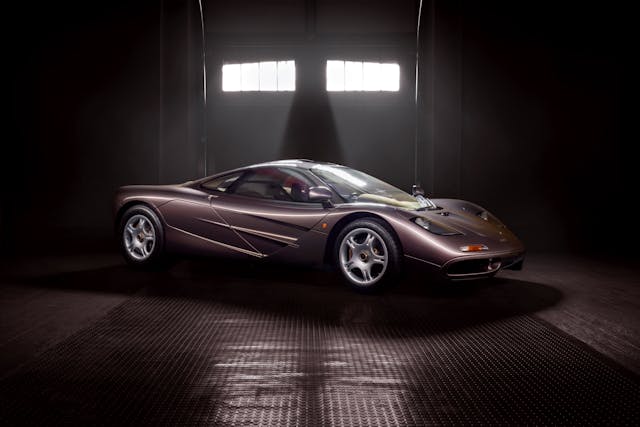
Estimate: In Excess of $15,000,000
Hagerty #2 (Excellent) Value: $18,500,000
You already know the McLaren F1 is arguably the greatest car ever created. But in case you missed the 1990s completely, here is some background:
The F1 was the fastest car in the world when first released in December 1992, achieving an official rev-limited top speed of 221 mph. In 1998, a prototype F1 with the rev-limiter increased to 8,300 rpm pushed the record to 240 mph, where it stood for almost ten years. The Bugatti Veyron eventually beat the F1’s record, but needed a 1000-horsepower quad-turbo 8.0-liter W16 in order to do so. The McLaren F1 still puts up a good fight against modern hypercars thanks to brilliant design and technology. Its BMW-sourced 6.1-liter S70/2 V-12 produced 618 hp—more than 100 horsepower per liter—without the aid of forced induction. The F1 is still one of the most powerful naturally-aspirated cars ever built and its 3.2 second 0-to-60 mph time is still impressive nearly 30 years later. The F1 is so great that even though it wasn’t initially designed for racing, it won the 1995 24 Hours of Le Mans. On its first try.

The sheer performance distracts from the practicality and comfort of the F1. With the center driver position, three adults can fit comfortably with enough storage for all their luggage and even a bespoke golf bag. All this in a car that barely weighs more than a Miata. The ultra-light 2500 pound curb weight was achieved with painstaking attention to detail and exotic materials like titanium, carbon fiber, and even gold. The attention to detail is staggering. To shave ounces, the onboard tool roll consists of gold-plated titanium tools. Did I mention the F1 still has air conditioning and a full stereo?
Unlike the F1 ‘LM Spec’ that sold in 2019, Chassis #029 offered at Gooding is a standard road car, although, its one-off Creighton Brown paint helps delineate it from the rest of the 64 F1 roadcars built. Delivered new to Japan, F1 #029 spent its first 17 years sitting in a look-but-don’t-touch collection, where it was likely only driven once at a promotional filming session near Tsukuba. Wearing the original Goodyear Eagle tires and showing less than 250 miles on the odometer at the time of cataloging, chassis #029 is among the “newest” F1s in existence. McLaren F1 prices have been on the rise, and this sale will likely push them further.
1998 Mercedes-Benz AMG CLK GTR Strassenversion
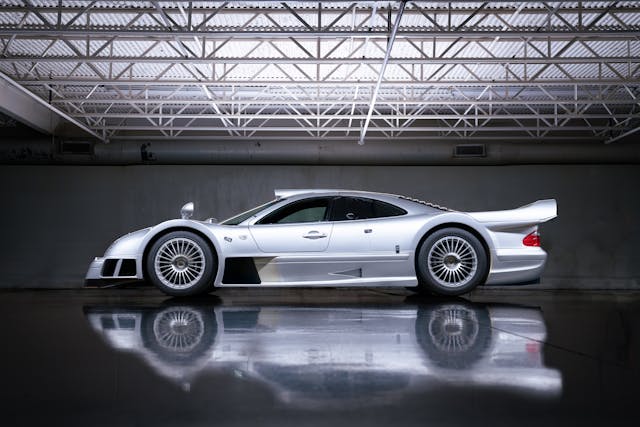
Estimate: $8,500,000–$10,000,000
Hagerty #2 (Excellent) Value: $5,750,000
The CLK GTR is a testament to what can be achieved in a short amount of time with proper planning and execution. Mercedes-Benz and AMG designed the car primarily for the newly created FIA GT Championship in 1997. By the time the project was greenlit, AMG had less than five months before the season started. To speed development, the team secretly purchased a McLaren F1 GTR race car to use as a sort of test mule, even going as far as modifying the McLaren with bodywork intended for the CLK GTR and replacing the engine with a 6.0-liter Mercedes V-12. This allowed AMG to perfect the aerodynamics before the car was built. Their shortcuts worked, and after just 128 days after starting the project, AMG entered two CLK GTRs into the 1997 FIA GT Championship season. The cars performed poorly in their first race, but by the fourth race the team had snagged first and second place, beating the McLaren F1. A CLK GTR, or the later modified CLK LM, would go on to win 17 of the 22 races it entered until the car’s retirement in 1998.

Unlike the McLaren F1, the CLK GTR was built solely with racing in mind. Mercedes sold just 25—the minimum required to comply with homologation rules. The massive roof scoop, myriad vents and inlets, and 23-spoke wheels hint that the CLK GTR wasn’t exactly conceived with grand touring in mind. The racing emphasis is also clear in the fact that this is the only car in the list that doesn’t have a conventional manual transmission. Instead, the 6.9-liter V-12 sends 604 horsepower to the rear wheels through a sequential manual gearbox operated by paddles behind the steering wheel (you still need to kick a clutch pedal). Further race car tech includes an engine fire suppression system and a removable steering wheel—possibly the only one ever to come standard with an airbag. To assist with quick trackside maintenance, the car had onboard hydraulic jacks, although the CLK GTR race cars had them removed.
Mercedes built 20 coupes and 5 roadsters to meet homologation standards. They are extremely uncommon at auctions. The CLK GTR has long been left in the shadows of the McLaren F1, but it appears the value gap is shrinking. At Monterey 2018, this same CLK GTR offered here sold for $4,515,000—or one-third the value of an F1 at the time. Now, the auction estimate is about half the current value of an F1. Even if the low estimate is hit, the seller will have doubled their investment. Not bad for parking a car for three years.
1994 Bugatti EB110 Super Sport
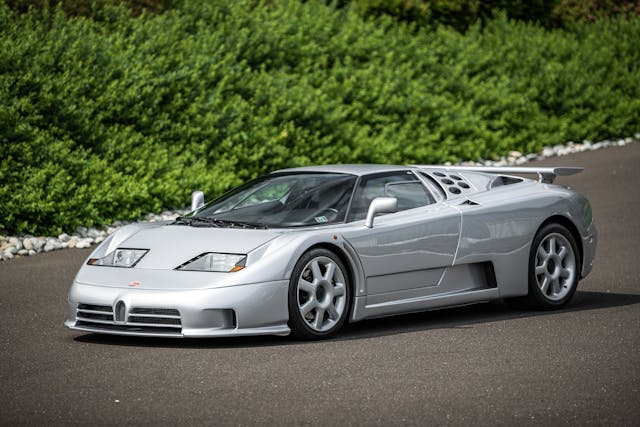
Estimate: $2,750,000–$3,000,000
Hagerty #2 (Excellent) Value: $1,750,000
After a 30-year hiatus, Bugatti was brought back to life by Italian entrepreneur Romano Artioli. But poor timing, bad press, and overextension led to the new Bugatti company going bankrupt in 1995. The sole product of this 8-year venture was 139 completed EB110s, including approximately 30 in Super Sport specification like the one offered here.
Built in Modena, Italy —a departure from Bugatti’s typical French origin—the EB110 debuted on founder Ettore Bugatti’s 110th birthday (hence the name). Like all modern Bugattis, the EB110 is a numbers car. Unlike its younger siblings, the Veyron and Chiron, which are powered by massive 8.0-liter quad-turbo W16, the EB110 relied on a small engine and light weight. Bugatti managed to squeeze 553 hp from a 3.5-liter V-12 by equipping four turbos and extending the rev-range to make peak power at a face-melting 8250 rpm.

Just six months later, Bugatti introduced the much lighter and faster Super Sport. Identifiable by its “swiss-cheese” B-pillar vents, the Super Sport had a new ECU, larger injectors, and a more free-flowing exhaust to increase power to 603 hp. Carbon-kevlar panels, rather than the standard car’s aluminum, along with magnesium BBS wheels, helped the SS drop to 3100 pounds, some 330 pounds lighter than the standard car and more than a 1000 pounds lighter than a Veyron. The EB110 SS’s top speed was just under 220 mph with a 3.2 second 0-60 time—still incredibly quick today.
If it hits RM Sotheby’s presale estimate, this EB110 SS will easily eclipse the current record for the model, which was set in 2018 in Paris when a Super Sport Prototype sold for $1.43 million. The fact that this particular Super Sport was recently displayed by Bugatti on the lawn at the 2019 Pebble Beach Concours d’Elegance at the unveiling of the Centodieci won’t hurt its chances.
1993 Jaguar XJ220
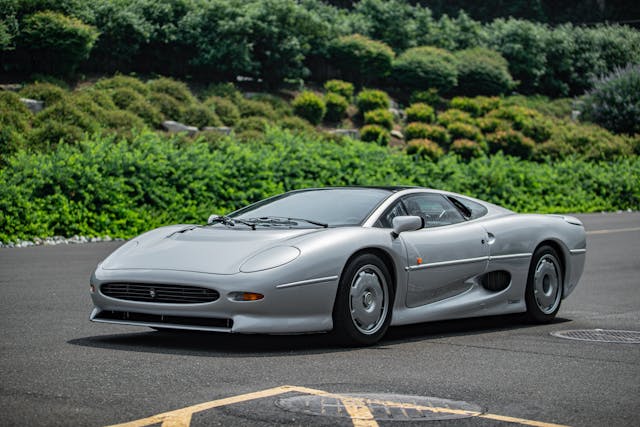
Estimate: $450,000 – $550,000
Hagerty #2 (Excellent) Value – $465,000
The XJ220 was designed after hours by a group of 12 Jaguar engineers and designers dubbed the “Saturday Club”, since they worked after hours on the project. The original concept, debuted in 1988, was a 500-horsepower 6.2-liter V-12-powered all-wheel-drive monster. But by the time the car made it to production, the V12 and all-wheel-drive was dropped in favor of a power-dense twin-turbo V-6 and rear-wheel-drive. On top of the less sexy drivetrain, the price rose from the originally-advertised £290,000 to nearly £490,000. This announcement caused many customers to demand Jaguar return their deposits, and the company only managed to sell about 280 of the originally planned run of 350. This drama severely hurt the car’s reputation and it never fully recovered. Despite the low production numbers and hypercar performance, values are still very low compared to it’s peers.
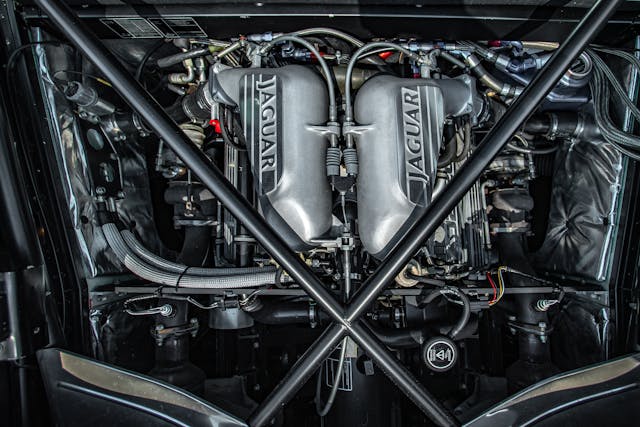
The XJ220 was named for it’s target top speed, but 220 mph ending up being harder to hit than the engineers first thought. Maybe it should have been named the XJ210 as its official top speed was clocked at 213 miles power hour at the Nardo test track in 1992. The XJ220 was the fastest car in the world for a brief time, before the McLaren F1 arrived a few months later. The XJ220’s all-aluminum twin-turbo V-6 was developed from the legendary MG Metro 6R4 Group B rally car and actually makes more power than the 6.2-liter V12 from the concept car—542 vs 500. Small-displacement turbo-sixes have now become normal in hypercars—just look at the new Ford GT. The XJ220 was just too ahead of it’s time and will continue to gain appreciation with age.
This XJ220 has been well maintained, with under 4500 miles and the original set of tires included in the sale. The car has changed hands a few times in past years and most recently sold for $483,500 in October 2020 as part of the Elkhart Collection. As most cars at the Elkhart Collection sold much higher than they should have, it will take a room full of enthusiastic bidders to give the current owner a satisfying flip.
1991 Jaguar XJR-15
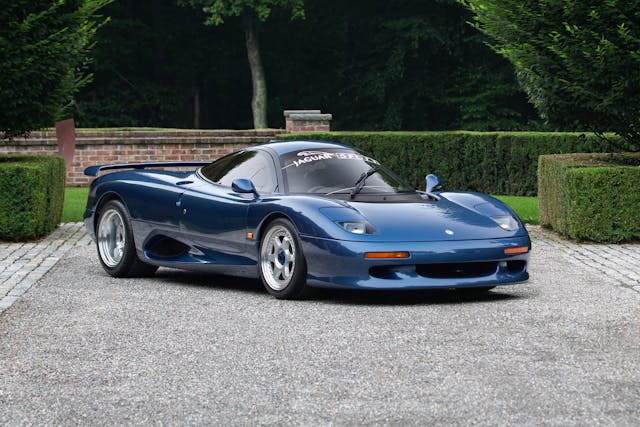
Estimate: $1,750,000–$2,100,000
Hagerty #2 (Excellent) Value: $1,850,000
Think “1990s Jaguar hypercar,” and the image that most likely pops into your brain is of the XJ220, the star-crossed, six-cylinder vehicle that arrived in 1992—just in time for a recession. You can, in fact, buy one of those at Monterey, but the spotlight next week will be on its brother, the XJR-15.
The XJR-15 is a road-going version of Jaguar’s legendary XJR-9 race car, which won the 1988 24 Hours of LeMans. Jaguar employed Peter Stevens, who later penned the McLaren F1’s body, to draft the XJR-15’s shape. The XJR-15 shares its carbon-fiber tub and suspension design with the XJR-9, which incorporates the 450-horsepower 6.0-liter Jaguar V-12 as a stressed member of the rear frame. Debuting in 1991, it was the first road-going car built entirely of carbon-kevlar composites, tipping the scales at just over 2300 pounds. Yes, a twelve-cylinder car that weighs just a bit more than a contemporary Miata.

Although it looks civilized—and more modern than the XJ220 despite being a few years older—the XJR-15 is a brutal machine. With the engine bolted directly to the chassis and no sound deadening, the car is so loud that Jaguar felt compelled to include race-car-like radio headsets so driver and passenger could communicate. It could sprint to 60 in 3.2 seconds and, if you kept your foot planted, it would eventually stop accelerating at a gear-limited to 191 mph.
Twenty-seven of the 53 total XJR-15s were road-going cars like this one, with the remaining built specifically for track use and participation in the Jaguar Intercontinental Challenge. Although they cost nearly $1,000,000 when new, there was a time when they weren’t worth much more than an XJ220. At Monterey 2011, a XJR-15 race car (possibly not-street-legal-at-the-time) went unsold with an estimate between $200K and $250K. At that same auction, a 1993 XJ220 sold for $231,000. That’s changed in recent years, as evidenced by this car’s seven-figure low estimate. Like the McLaren F1 on this list, this XJR-15 was delivered new to Japan and never driven, showing only 78 miles on the odometer. The crowd will be bidding on a brand-new, 30-year-old race car.
1995 Ferrari F50

Estimate: $3,600,000 – $4,000,000
Hagerty #2 (Excellent) Value – $2,100,000
It says something about this list that the Ferrari F50 has the highest production of any car here—with 349 examples produced and only 55 delivered to the States.
The 1990s were, as we noted, a time of transition for hypercars. The F50 perfectly captures that transition. It is, depending upon how you look at it, the most advanced of Ferrari’s analog halo cars or the most analog of its modern halo cars. It is powered by a naturally-aspirated V-12 connected to gated six-speed manual transmission, yet has the carbon-fiber tub construction that we’d see carried through the Enzo and LaFerrari. It also wears oh-so-1990s styling that was, for many collectors, a turn off. Younger enthusiasts seem more forgiving of its looks, however, and values are rising.

This Ferrari F50 is one of the original 55 delivered new to the United States, where it remained with the original owner until 2018. It was meticulously maintained during ownership and even saw the same technician, Thomas Passalacqua, during that time. With only 8375 miles from new and the “Best F50” award at Cavallino XXIX, this F50 will very likely to sell well. If the high estimate is hit, it will break the current F50 record of $3.77-million that was set a few months ago at RM Amelia Island 2021.
Although all F50s were built with removable hardtops, notice that the auction pictures only show this car as a convertible. There’s good reason for that: Installing or removing the hardtop required about 4 hours of service at a Ferrari dealership. Included in the sale is the “circus box” that houses the roof and additional hardware while the car is in open-top configuration, as well as serialized carbon fiber luggage by Schedoni.
